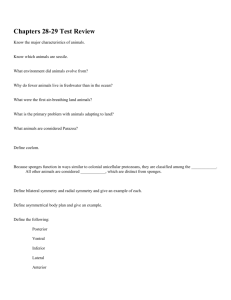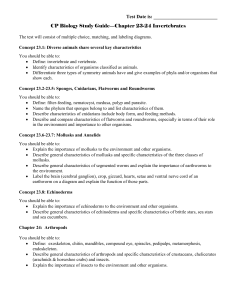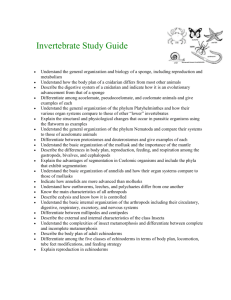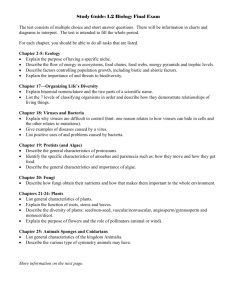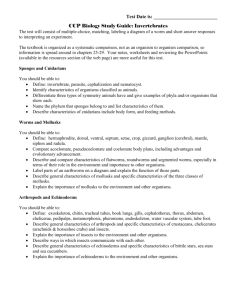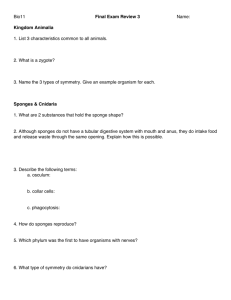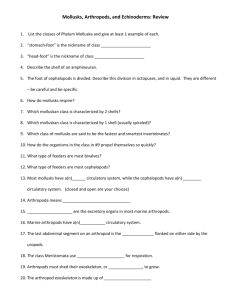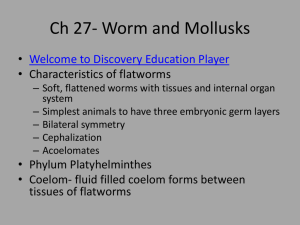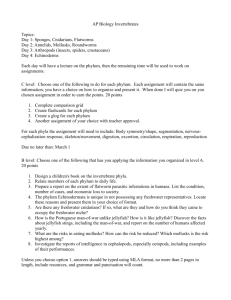Invertebrate Packet
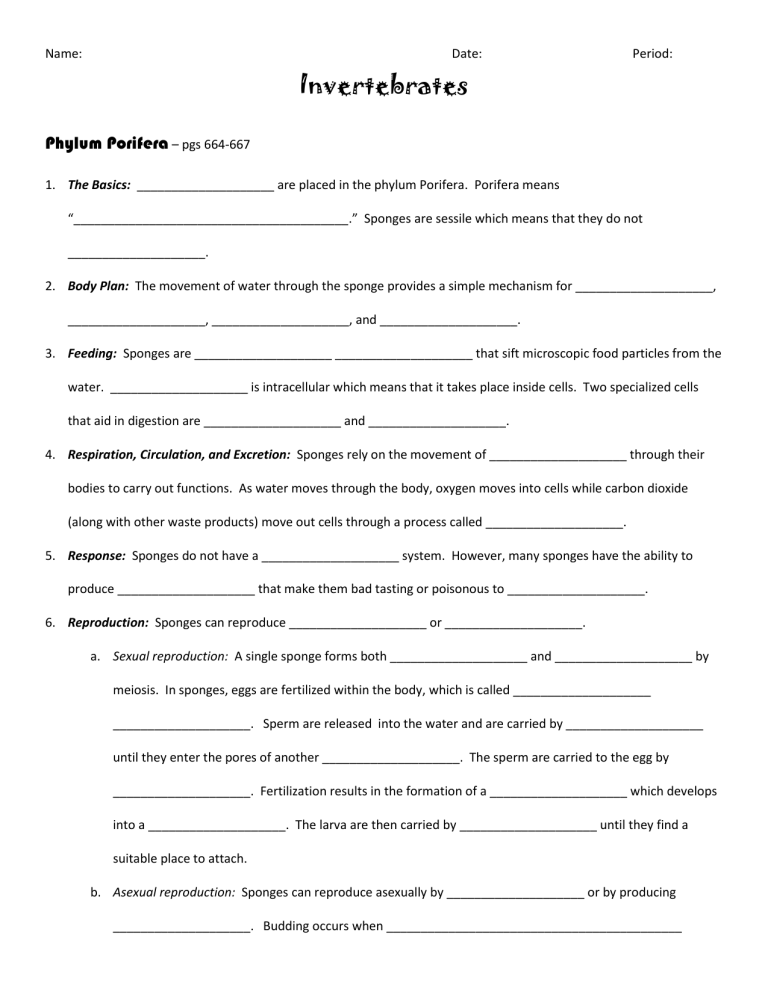
Name: Date:
Invertebrates
Phylum Porifera
– pgs 664-667
1.
The Basics: ____________________ are placed in the phylum Porifera. Porifera means
Period:
“________________________________________.” Sponges are sessile which means that they do not
____________________.
2.
Body Plan: The movement of water through the sponge provides a simple mechanism for ____________________,
____________________, ____________________, and ____________________.
3.
Feeding: Sponges are ____________________ ____________________ that sift microscopic food particles from the water. ____________________ is intracellular which means that it takes place inside cells. Two specialized cells that aid in digestion are ____________________ and ____________________.
4.
Respiration, Circulation, and Excretion: Sponges rely on the movement of ____________________ through their bodies to carry out functions. As water moves through the body, oxygen moves into cells while carbon dioxide
(along with other waste products) move out cells through a process called ____________________.
5.
Response: Sponges do not have a ____________________ system. However, many sponges have the ability to produce ____________________ that make them bad tasting or poisonous to ____________________.
6.
Reproduction: Sponges can reproduce ____________________ or ____________________. a.
Sexual reproduction: A single sponge forms both ____________________ and ____________________ by meiosis. In sponges, eggs are fertilized within the body, which is called ____________________
____________________. Sperm are released into the water and are carried by ____________________ until they enter the pores of another ____________________. The sperm are carried to the egg by
____________________. Fertilization results in the formation of a ____________________ which develops into a ____________________. The larva are then carried by ____________________ until they find a suitable place to attach. b.
Asexual reproduction: Sponges can reproduce asexually by ____________________ or by producing
____________________. Budding occurs when ___________________________________________
_________________________________________________________. Some sponges have the ability to produce gemmules during _________________________________________________________________.
Phylum Cnidaria
– pgs 669-675
7.
The Basics: Four examples of organisms found in phylum Cnidaria are ____________________,
____________________, ____________________, and ____________________. Cnidarians get their name from the ____________________ that are located along their tentacles. These cnidocytes are used for
____________________________________________________________. Each cnidocyte contains a
____________________. A nematocyst is a ___________________________________________________________
________________________________________.
8.
Body Plan: Cnidarians are ____________________ symmetrical. They have a central mouth surrounded by
____________________. Cnidarians have two different stages: ____________________ and
____________________. In the ____________________ stage, the mouth points upward. A
____________________ has a motile, ________________________________________ body with the mouth on the
____________________.
9.
Feeding: The prey is pulled through the mouth and into the ________________________________________. The digestive system of cnidarians only has ____________________ opening. Having only one opening means that
________________________________________________________________________________. Digestion is extracellular meaning ____________________________________________________________________________.
10.
Respiration, Circulation, and Excretion: Nutrients are usually transported by ____________________. Cnidarians respire and eliminate wastes of cellular processes by ____________________ through ____________________.
11.
Response: Cnidarians have a ____________________ which is a loosely organized network of nerve cells that allow them to detect ____________________.
12.
Reproduction: Most reproduce both ____________________ and ____________________. Polyps can reproduce asexually by ____________________. For many cnidarians sexual reproduction takes with external fertilization in the water. External fertilization means ____________________________________________________________.
Many times there are separate sexes and the females release ____________________ and the males release
____________________.
Phylum Platyhelminthes
– pgs 683-688
13.
The Basics: Phylum Platyhelminthes consists of ____________________. Most are only a few
____________________ thick. Flatworms are soft, flattened worms that have ____________________ and internal
____________________ systems. They have three ____________________ germ layers, ____________________ symmetry, and ____________________. Flatworms are known as acoelomates, which means _________________
______________________________________________________________________________________________.
14.
Feeding: Free-living flatworms can be ____________________ that feed on tiny aquatic animals or they can be
____________________ that feed on recently dead organisms. Flatworms have digestive cavity with single opening, or mouth, through which ____________________ and ____________________ pass. The pharynx plays a role in digestion by ________________________________________________________________________________
______________________________________________________________________________________________.
Once inside, food is digested by ________________________________________, where digestion and
____________________ absorption take place. Digested food ____________________ from the digestive cavity into the body tissues. Parasitic worms feed on ____________________, ____________________, or pieces of cells within the host’s body and have a much simpler ________________________________________.
15.
Respiration, Circulation, and Excretion: Flatworms rely on ____________________ to transport oxygen and
____________________ to their internal tissues, and to remove ____________________ and other
____________________ from their bodies. Flatworms have no ____________________ or other respiratory organs, an no ____________________, ____________________, or blood. Some flatworms have flame cells that
________________________________________________________________________________.
16.
Response: In free-living flatworms, a head encloses several ____________________, or gropus of nerve cells, that control the ________________________________________. They have also what look like eyes near the anterior end of their bodies. Each “eye” is an eyespot, which is group of ____________________ that can detect
____________________________________________________________. The nervous systems of flatworms allow
them gather information which helps them to ________________________________________________________
_____________________________________________________________________________________________.
17.
Reproduction: Most flatworms are ____________________ that reproduce ____________________. A hermaphrodite is an individual that has ____________________________________________________________.
Asexual reproduction is also common and takes place by ____________________. Fission occurs when
______________________________________________________________________________________________.
Phylum Nematoda
– pgs 689-693
18.
The Basics: Roundworms are slender, ____________________ worms with ____________________ ends. They can range in size from ____________________ to a ____________________ in length. Most species are free-living, inhabiting ____________________, ____________________, aquatic sediments, and water. Many others are
____________________ and live within a host. Roundworms have a pseudocoelom which means
________________________________________.
19.
Feeding: Many are ____________________ that use grasping mouth parts and ____________________ to catch and eat small ____________________. Others eat ____________________, fungi, or pieces of
________________________________________.
20.
Respiration, Circulation, and Excretion: Roundworms exchanged gases and excrete metabolic waste through their
____________________ through a process called ____________________.
21.
Response: They have a simple ____________________ system that consists of several ____________________.
Several nerves extend from the ____________________ and run the length of the ____________________. These nerves transmit ____________________ info and control ____________________.
22.
Reproduction: They reproduce ____________________, and most species haveseparate ____________________.
They reproduce using ____________________ fertilization meaning ______________________________________
________________________________________________________________________________.
Phylum Annelida
– pgs 694-699
23.
The Basics: The name Annilda refers to the ____________________ appearance of annelids’ body
____________________. The body of an annelid is divided into ____________________ that are separated by
____________________. In many annelids, bristles called ____________________ are attached to each segment.
They have a true ____________________ that is lined with tissue derived from the ____________________.
24.
Feeding and Digestion: Annelids range from ____________________ feeders to ____________________. Many annelids get their food using a ____________________ which, in carnivorous species, can hold
________________________________________ to attack ____________________. In annelids that feed on decaying vegetation, the pharynx is covered with ________________________________________. In earthworms, the ____________________ pumps food and soil into a tube called an ____________________. The food then moves through the ____________________, and through the ____________________. The food is absorbed farther along in the digestive tract, in an organ called the ____________________.
25.
Circulation: Annelids typically have a ____________________ circulatory system, which means ________________
______________________________________________________________________________________________.
Blood circulates through two major blood vessels called the ____________________ blood vessel and
____________________ blood vessel. The dorsal blood vessel functions like a heart because it
______________________________________________________________________________________________.
26.
Respiration: Aquatic annelids breathe through ____________________. A gill is an organ specialized for
____________________________________________________________. Land-dwelling annelids take in
____________________ and give off ____________________ through their moist ____________________.
27.
Response: Most annelids have a well-developed ____________________ system that consists of a
____________________ and several ____________________. Many species have a variety of adaptations for detecting stimuli such as sensory ____________________, chemical ____________________, statocysts that help detect ____________________, and two or more pairs of ____________________.
28.
Reproduction: Most reproduce ____________________. Some species use ____________________ fertilization and have separate ____________________. Other annelids are ____________________, but typically do not fertilize their own ____________________. When eggs are ready for fertilization, a clitellum secretes a mucus ring into which ____________________________________________________________. The ring then slips off the body and forms a protective ____________________.
Phylum Mollusca
– pgs 701-708
29.
The Basics: Mollusks are ____________________ animals that usually have an internal or external
____________________. Mollusks include ____________________, ____________________,
____________________, ____________________, and ____________________. Why are these animals placed in the same phylum? Many mollusks share similar ____________________ stages. Aquatic mollusks have a larval stage called a ____________________.
30.
Body Plan: The body plan of most mollusks has four parts: ____________________, ____________________,
____________________, and ____________________. The muscular ____________________can be used for
____________________, ____________________, or for capturing ____________________. The
____________________ is a thin layer of tissue that covers most of the body. The ____________________ is made by glands in the mantle that secrete ________________________________________. The visceral mass consists of the ____________________.
31.
Feeding: Mollusks can be ____________________, ____________________, ____________________,
____________________, or parasites. Snails and slugs feed using a radula which contains hundreds of
________________________________________. Octopi and sea lugs use their sharp ____________________ to eat prey. Some also produce ____________________ to subdue prey. Clams, oysters, and scallops are
____________________-feeders and use feathery ____________________.
32.
Respiration: Aquatic mollusks typically breathe using ____________________. As water passes through the mantle cavity, ____________________ in the water moves into the blood while carbon dioxide moves out of the
____________________ and into the water. Land mollusks respire using a mantle cavity that has a large
________________________________________ lined with blood ____________________. Because they rely on diffusion, land snails and slugs usually live in ____________________ places.
33.
Circulation: ____________________ and ____________________ are carried to all parts of a mollusk’s body by a circulatory system. Mollusks can either have an ____________________ or ____________________ circulatory system. Having an open circulatory system means that ________________________________________
________________________________________________________________________________. Slow moving
mollusks such as snails and clams have an ____________________ circulatory system, whereas faster moving mollusks such as squid and octopi have a ____________________ circulatory system.
34.
Excretion: Cells of the body release ____________________-containing waste into the blood in the form of
____________________. Tube-shaped ____________________ remove ammonia from the blood and release it outside the body.
35.
Response: Clams and other two-shelled mollusks have a simple ____________________ system consisting of small
____________________ near the mouth, a few nerve ____________________, and simple sense organs, such as
____________________ receptors and ____________________. Octopi and their relatives are active and
____________________ predators that have the most highly developed nervous system of all
____________________. These animals can ____________________ things for long periods and may be more intelligent than some ____________________. Octopi are capable of ____________________ behavior and can be trained to perform tasks for a reward.
36.
Reproduction: Many snails and two-shelled mollusks reproduce ____________________ by
____________________ fertilization. They ____________________ enormous numbers of ____________________ and ____________________ into the open water. After fertilization, the eggs develop into free-swimming
____________________. In tentacles mollusks, fertilization takes place inside the ____________________. Some mollusks are ____________________, having both male and female reproductive structures.
Phylum Arthropoda
– pgs 715-733
37.
The Basics: Arthropods have a ____________________ body, a tough ____________________, and jointed
____________________. The purpose of the exoskeleton is to ________________________________________
____________________________________________________________. The exoskeleton is made from a protein and a carbohydrate called ____________________. The exoskeletons of many terrestrial species have a waxy covering that ________________________________________________________________________________.
____________________ are structures such as legs and antennae that extend from the ____________________.
38.
Feeding: Arthropods include herbivores, ____________________, and ____________________. They have mouthparts have evolved in ways that enable different species to eat almost anything. These mouthparts range
from ____________________ or fangs to ____________________ jaws that can cut through the tissues of captured prey.
39.
Respiration: Most terrestrial arthropods breathe through a network of branching ____________________ that extend throughout the body. Air enters and leaves the tracheal tubes through ____________________, which are small openings located along the side of the ____________________. Others (such as spiders) respire using
____________________, which are organs that have layers of respiratory ____________________ stacked like the pages of a book. Aquatic arthropods, such as lobsters and crabs, respire through ____________________.
40.
Circulation: Arthropods have an ____________________ circulatory system. A well-developed
____________________ pumps blood through ____________________ that branch and enters
____________________. Blood leaves the vessels and moves through ____________________. The blood then collects in a large ____________________ surrounding the ____________________. From there it re-enters the
____________________ and is pumped through the ____________________ again.
41.
Excretion: Most terrestrial arthropods dispose of nitrogenous wastes using _______________________________, which are saclike organs that extract wastes from the ____________________, that move through the
____________________. In aquatic arthropods, ____________________ moves cellular wastes from the body into the surrounding ____________________.
42.
Response: Most arthropods have a well-developed ____________________ system. All arthropods have a
____________________ which serves as a central switchboard that receives incoming ____________________ and then sends outgoing instructions to ____________________. Along this nerve cord are several
____________________, which coordinate ____________________ of legs and wings.
43.
Reproduction: Terrestrial arthropods have ____________________ fertilization. In some species, males have a reproductive organ that places ____________________ inside the female. In others, the males deposit a
____________________ packet that is picked up by the ____________________. Aquatic arthropods may have either ____________________ or ____________________ fertilization which means fertilization takes places outside the ____________________ body. It occurs when females release ____________________ into the water and males release ____________________ around the eggs.
Phylum Echinodermata
– pgs 734-738
44.
The Basics: Three examples of echinoderms are ____________________, ____________________, and
____________________. The skin of echinoderms is stretched over an internal skeleton called an
____________________. The endoskeleton is formed of hardened plates of ____________________.
Echinoderms are characterized by spiny ____________________, an internal ____________________, a
________________________________________ system, and ____________________ (little suction cups) and most exhibit ____________________ symmetry.
45.
Form and Function: The water vascular system carries out many functions including ____________________,
____________________, and ____________________. Echinoderms also have hundreds of
____________________, which is a structure that operates much like a ____________________. Hundreds of tube feet together create enormous force, allowing echinoderms to ____________________ and even pull open
________________________________________.
46.
Feeding: Echinoderms have several methods of ____________________. Sea urchins use a
____________________ structure to ____________________________________________________________. Sea lilies use ____________________ to capture floating plankton. Sea cucumbers feed on
______________________________. Sea stars usually feed on ____________________ and
____________________. The sea star eats by pushing its ____________________ out through the mouth, pouring out enzymes, and digesting the mollusk in its own ____________________. After, the sea star pulls its
____________________ and the ____________________ into its mouth.
47.
Respiration and Circulation: Echinoderms mostly rely on the ________________________________________ system for respiration and circulation. However, the thin-walled tissues of the ____________________ provide the main surface for ____________________. Some species also have ____________________ that also function in gas exchange. ____________________, ____________________, and ____________________ are all carried by the
________________________________________ system.
48.
Excretion: In most echinoderms, digestive wastes are released as ____________________ through the
____________________. Cellular wastes are excreted in the form of ____________________ through
____________________ and ____________________.
49.
Response: Most echinoderms have a ____________________ that surrounds the ____________________ and radial nerves that connect the rings with the ____________________ sections. They also have scattered
____________________ cells that detect ____________________, ____________________, and
____________________ release by potential prey.
50.
Reproduction: Echinoderms reproduce by ____________________ fertilization. ____________________ are produced by the testes and ____________________ are produced by the ovaries. Both ____________________ are shed into ____________________ where fertilization takes place.
